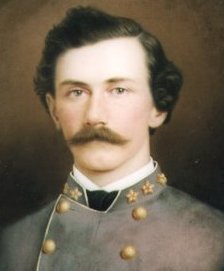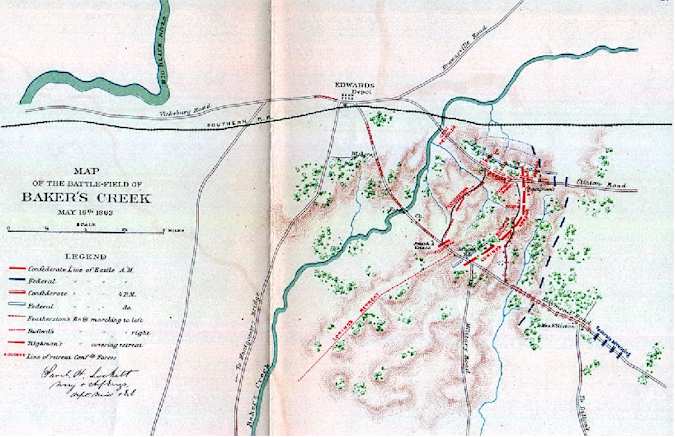|
Maj. Samuel H. Lockett,
C. S. Engineer Corps,
Having returned from an examination of the works at Grand Gulf on April 30, 1 received, at Jackson, an order to join the lieutenant-general commanding at Vicksburg, which I did on May 2. The enemy having effected a landing at Bruinsburg, Miss., and forced the evacuation of Grand Gulf on April 30, it became evident that immediate steps would have to be taken to meet him on all available approaches to the city of Vicksburg. The several ferries across the Big Black River and the railroad bridge became points of great strategic importance. I accordingly dispatched an engineer officer to each of these points with the view of establishing works for resisting a passage of the river by the enemy. On examination it was found that at Baldwin's, Hall's, and Hankinson's Ferries the bluffs abutted against the river on the east bank, leaving wide bottoms on the west, so that at each of these crossings it became necessary to construct a tÍte-de-pont or to relinquish the idea of taking the river as a line of defense. These tÍtes-de-pont were ordered, but before anything could be done the army of Grand Gulf, under Major-General Loring, had crossed the river at Hankinson's Ferry, leaving the east bank in possession of the enemy. During this time I had gone myself, by the direction of the lieutenant-general, to the railroad bridge and Edwards Depot, to establish works to defend the railroad and preserve this very important line of communication. Having examined the ground, I directed Capt. D. Wintter, commanding corps of sappers and miners, to take charge of the construction of a tÍte-de-pont to cover railroad bridge, and telegraphed to Capt. P. Robinson, of the engineers, at Grenada, to report to me at Edwards Depot with all his assistant engineers. Captain Robinson reported on the 9th, and leaving him in charge of the works at the bridge, and directing him to make thorough reconnaissances of the country in the vicinity of Edwards Depot and to the southward, I returned to Vicksburg with Captain Wintter, and put him in charge of all the works around the city, to make necessary repairs and put everything in good condition. The tÍte-de-pont at the railroad bridge was pushed ahead rapidly, and finished by the 15th, and at the same time a bridge was made across the Big Black by swinging the steamer Dot across the stream and removing her machinery. On the 12th, the army was ordered across the Big Black to Edwards Depot, and I went to the latter place to conduct the division command-ors to the positions assigned to them by the lieutenant-general commanding. On the 15th, orders were received to march upon the enemy, and I took with me in accompanying the lieutenant-general the following assistant engineers, viz: Second Lieut. George Donnellan, engineers; Capt. J. M. Couper and Sergt. S. McD. Vernon, acting assistant engineers, leaving Captain Robinson and three assistants in charge of the works at the bridge. No engineer operations were found necessary on the march, and the army reached its destination on the Raymond road about midnight on the 15th, the head of the column being halted beyond Mrs. Ellison's house, some 6 miles from Edwards Depot. THE BATTLE OF BAKER'S CREEK, MAY 16. At 6.30 a.m. on the 16th, a courier from General Johnston arrived, bringing information to the lieutenant-general commanding which made a countermarch necessary. I was directed by the lieutenant-general to inform the division commanders that such a move would be made immediately, and communicated his instructions to Major-General Stevenson and Brigadier-General Bowen. I returned to headquarters at Mrs. Ellison's about 7.30, and heard as I reached the house the enemy's artillery open on the head of our column on the Raymond road. I was then directed by the lieutenant-general to inform Major-General Stevenson that it would be necessary to form his division in line of battle on the cross-road from the Clinton to the Raymond road, with his left flank covering the former. Having communicated these instructions, I sent Sergeant Vernon to get a pioneer company from General Cumming's brigade, and directed him to throw a bridge as soon as possible across Baker's Creek, on the main Raymond road, where the county bridge had been washed away. This bridge was constructed and the banks of the creek cut down leading to it by 2 p.m. From 8 a.m. until about 11, I was engaged with my assistants in communicating orders from the lieutenant-general commanding in regard to the formation of the line of battle, which was formed on a commanding ridge, and so disposed as to cover all approaches from the front.
About noon the battle opened
with considerable vigor on the left, and the enemy making an attempt to
turn our left flank, rendered a corresponding movement necessary on our
part. This movement opened a considerable gap between the divisions of
Generals Stevenson and Bowen, and I carried an order from the
lieutenant-general to General Bowen to keep the interval closed between
himself and General Stevenson, and to General Loring to the same effect
in reference to his and General Bowen's divisions. Between this and 3
p.m. I carried an order to General Loring to hold his whole division in
readiness to move to the left, and to move his left brigade (General
Buford's) at once to join upon the right of General Bowen's command.
Between 4 and 5 o'clock the enemy had succeeded by his vastly superior
numbers in completely turning our left, and our troops began to break
and fall back in considerable disorder toward the main Raymond road. I
was then directed by the lieutenant-general to inform General Tilghman
that the position he occupied was one of vast importance in securing our
retreat, and that he must hold it at all hazards. I found General
Tilghman had moved his brigade, and was marching along a by-road toward
our left. On receiving the above order, he halted his command, and,
facing about, returned to the Raymond road, and took a position on a
ridge some 600 yards in rear of his first [position], and just in front
of the by-road above mentioned, along which our army finally retreated.
SAMUEL H. LOCKETT, Maj. R. W. MEMMINGER, |
|
| Home | Grant's March | Pemberton's March | Battle of Champion Hill | Order of Battle | Diaries & Accounts | Official Records | | History | Re-enactments | Book Store | Battlefield Tour | Visitors | Copyright (c) James and Rebecca Drake, 1998 - 2002. All Rights Reserved. |
 SIR:
I have the honor herein to submit my report of engineer operations
during the period included between the dates May 2 and May 18,
comprehending the events immediately preceding the siege of Vicksburg.
SIR:
I have the honor herein to submit my report of engineer operations
during the period included between the dates May 2 and May 18,
comprehending the events immediately preceding the siege of Vicksburg.